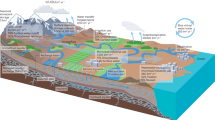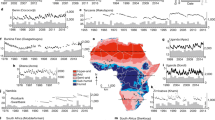Abstract
Air pollution imposes enormous public health and economic burdens in northwest India. Groundwater conservation policies appear to be exacerbating the crisis by concentrating agricultural burning in the late fall with a 39% higher peak fire intensity occurring when meteorological conditions favour poor air quality. Reconciling food security, resource depletion and environmental quality tradeoffs is necessary for achieving sustainable development in the breadbasket region of India.
This is a preview of subscription content, access via your institution
Access options
Access Nature and 54 other Nature Portfolio journals
Get Nature+, our best-value online-access subscription
$29.99 / 30 days
cancel any time
Subscribe to this journal
Receive 12 digital issues and online access to articles
$119.00 per year
only $9.92 per issue
Buy this article
- Purchase on Springer Link
- Instant access to full article PDF
Prices may be subject to local taxes which are calculated during checkout


Similar content being viewed by others
Data availability
MODIS EVI data were acquired from the NASA Land Data Products and Services portal: https://lpdaac.usgs.gov/products/mod13q1v006/. MODIS active fire data were acquired from the Fire Information for Resource Management System: https://firms.modaps.eosdis.nasa.gov/download/. Measured PM2.5 data for New Delhi were acquired from the National Ambient Air Quality Monitoring Network that aggregates information from 27 air quality monitoring stations that are distributed across the capital region. Year-wise daily data are available from the Government of India (note: filter results for ‘Delhi’): https://data.gov.in/catalog/historical-daily-ambient-air-quality-data. Satellite-estimated PM2.5 data for New Delhi were acquired from the University of Miami: http://precise.miami.edu/index_delhi.php. Rice yield data for Punjab and Haryana were compiled from various Government of India sources: https://aps.dac.gov.in/APY/Public_Report1.aspx, https://nfsm.gov.in/ReadyReckoner/NFSMRR/NFSM_AllocationReleases2018.pdf and http://esaharyana.gov.in/en-us/Economic-Survey-of-Haryana-2016-17-English. Weather data for New Delhi were acquired from the Indian Agricultural Research Institute: http://www.iari.res.in/index.php?Itemid=1033&id=402&option=com_content&view=article. Political boundaries depicted in our maps are distributed as spatial data by GADM (www.gadm.org).
References
Bikkina, S. Nat. Sustain. 2, 200–205 (2019).
Cusworth, D. H. et al. Environ. Res. Lett. 13, 044018 (2018).
Landrigan, P. L. et al. Lancet 391, 462–512 (2017).
Ghude, S. D. et al. Geophys. Res. Lett. 43, 4650–4658 (2016).
Guttikunda, S. K. & Goel, R. Environ. Dev. 6, 8–20 (2013).
Chowdhury, S. et al. Environ. Sci. Policy 74, 8–13 (2017).
Dey, S. et al. Remote Sens. Environ. 127, 153–161 (2012).
Liu, T. et al. Atmos. Environ. 172, 83–92 (2018).
Jethva, H. et al. Aerosol Air Qual. Res. 18, 1756–1773 (2018).
Rajput, P. et al. Atmos. Environ. 45, 6732–6740 (2011).
Ortiz-Monasterio, J. I. et al. Field Crops Res. 37, 169–184 (1994).
Ahmad, T. et al. Land Use Policy 47, 448–458 (2015).
Rodell, M., Velicogna, I. & Famiglietti, J. S. Nature 460, 999–1001 (2009).
Humphreys, E. et al. Adv. Agron. 109, 155–217 (2010).
Chhatre, A. et al. Decision 43, 167–179 (2016).
Singh, B. et al. Field Crops Res. 173, 68–80 (2015).
Singh, R. P. & Kaskaoutis, D. G. Eos 95, 333–340 (2014).
Guttikunda, S. K. & Jawahar, P. Atmos. Environ. 92, 449–460 (2014).
Bollasina, M. A. et al. Science 334, 502–505 (2011).
Sidhu, H. S. et al. Field Crops Res. 184, 201–212 (2015).
Sidhu, H. S. et al. Agric. Water Manag. 216, 273–283 (2018).
Boschetti, M. et al. Int. J. Remote Sens. 30, 4643–4662 (2009).
Eckmann et al. Earth Interact. 14, 1–29 (2010).
Zhang et al. Remote Sens. Environ. 198, 407–424 (2017).
Kumar, N. et al. Atmos. Environ. 41, 4492–4503 (2007).
Acknowledgements
We recognize early investigative journalism that hypothesized associations between the Groundwater Acts and the air pollution crisis in northwest India (see S. Narain, Straw in the wind. Business Standard, 15 February 2015; https://go.nature.com/36lsmhR). We commend this and similar efforts (for example, A. Kumar, Monsanto’s profits, not Diwali, creating smoke in Delhi. The Sunday Guardian, 3 November 2018; https://go.nature.com/3jks92f), and acknowledge the vital role of journalism for shaping and supporting innovative sustainability science.
Author information
Authors and Affiliations
Contributions
B.-S. and A.J.M. conceptualized the study and were the principal drafters of the manuscript. A.K.S. developed the analytical methods and conducted the geospatial analyses. B.G. contextualized the research within broader frameworks for sustainable intensification, and contributed to the manuscript accordingly.
Corresponding author
Ethics declarations
Competing interests
The authors declare no competing interests.
Additional information
Publisher’s note: Springer Nature remains neutral with regard to jurisdictional claims in published maps and institutional affiliations.
Supplementary information
Supplementary Information
Supplemental Figs. 1–4
Rights and permissions
About this article
Cite this article
Balwinder-Singh, McDonald, A.J., Srivastava, A.K. et al. Tradeoffs between groundwater conservation and air pollution from agricultural fires in northwest India. Nat Sustain 2, 580–583 (2019). https://doi.org/10.1038/s41893-019-0304-4
Received:
Accepted:
Published:
Issue Date:
DOI: https://doi.org/10.1038/s41893-019-0304-4
This article is cited by
-
Incentivizing alternatives to agricultural waste burning in Northern India: trust, awareness, and access as barriers to adoption
Environment Systems and Decisions (2023)
-
Very high particulate pollution over northwest India captured by a high-density in situ sensor network
Scientific Reports (2023)
-
Time management governs climate resilience and productivity in the coupled rice–wheat cropping systems of eastern India
Nature Food (2022)
-
Long term influence of groundwater preservation policy on stubble burning and air pollution over North-West India
Scientific Reports (2022)
-
Air quality impacts of crop residue burning in India and mitigation alternatives
Nature Communications (2022)



